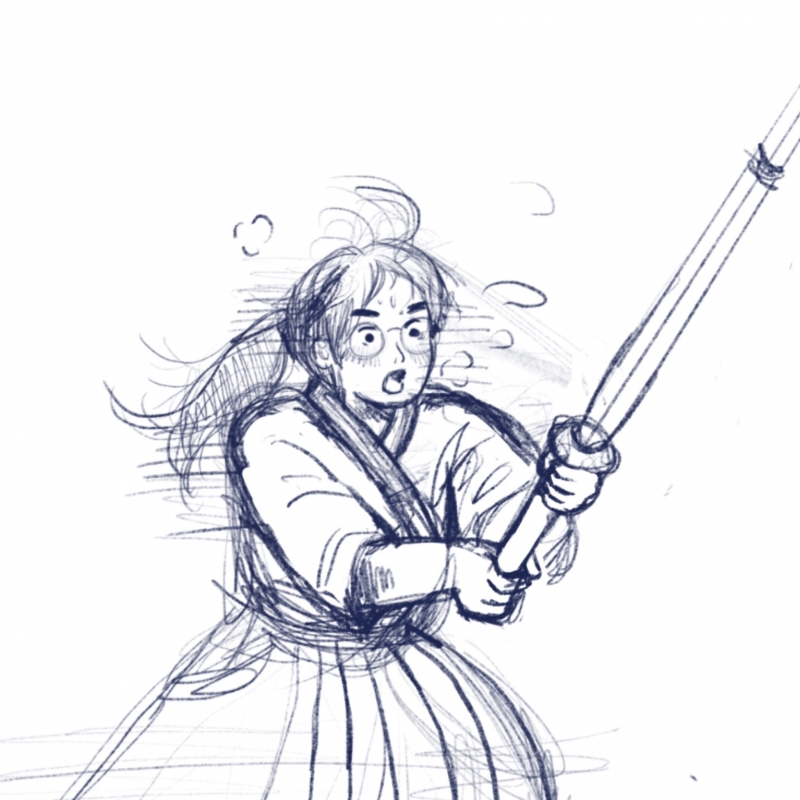Subscribe
Subscribe to our quarterly email newsletter 「ICM News」 to receive recent news about ICM, diverse writings by experts and youth, and relevant information.
Title [Martial Arts Globe] Repeated Practice to Drop a Bad Habit

Drawn by author. LEE so
“When you strike the head, you shouldn’t keep making
movements that are out of beat” “When you strike the wrist your body tilts to the
side. Your opponent is likely to use it to attack you.”
I’ve been practicing kendo for more than ten years. Although
it seems that I train similar things every day, the performance of the practice
varies largely depending on my condition.
I wonder if any other
practitioner of other martial arts would agree with me. One day everything is fine,
but on another day, my body does not work well. On the day I do not do good, senior
practitioners point out my inappropriate posture. As soon as I stop being
attentive to my movements, my posture immediately turns bad. Maybe my body only
wants to feel comfortable. It’s difficult learning the right posture even with
help, but performing bad postures doesn’t even need teaching. Very interesting.
“I cannot believe I’m not able to perform what I
could yesterday!”
There are moments I feel ridiculous about myself.
It is annoying when you find it hard to perform skills that you had finally
acquired after hard work, make a mistake in the basic footwork, or put your
left hand on the wrong location of a bamboo sword. If you ask me whether I skip
practice a lot, the answer is no (Maybe it’s just me who thinks so). It is quite
unfair for me because I try to practice every day if it isn’t for inevitable situations.
Anyway, when I receive many negative comments about my practice, my brain becomes
busy remembering all of them.
I need to tuck in my hips
and fix my left foot to point straight! Whenever I think about my hips, I mess
up with my left foot, and vice versa. Apparently, I have failed to fix both
things at once. I know there is only one way to fix the situation: settling
things one by one after listing up the points I need to improve. I feel related
to other amateur kendo practitioners who posted on blogs or Twitter about the
bad feedbacks they had received during practice. Because I enjoy handwriting, I
usually write them down in my notebook.
Then I walk through what I
wrote. They are divided into two parts: things that are hard to fix, and those that
are not. I first look into the things I can make an improvement right away with
a bit of determination. For instance, you might have a bad habit of releasing the
right-hand grip on the sword. As for this issue, you can make a quick
improvement if you decide not to. Of course, it will take some time to get used
to it, as you need to intentionally think about it.
On the other hand, if you want
your left foot to follow up quickly, you need to raise the strength and speed
of your left foot through steady practice. Regardless of the next attack you’d
like to make, your right foot should be placed forward followed by the left
foot. The left foot plays an important role by pushing the body forward. The
movement should be followed up with your right foot swiftly. Only then you can continue
your moves even if you fail your attack once. Therefore, kendo practitioners
often say that most skills of kendo start from the left foot. Given the
significance, you should continuously practice pushing your body forward with your
left foot. But it is really easy to forget to put strength in your left foot,
no matter how hard you try.
This kind of approach doesn’t
lead to the kind of achievement you feel at once. I understand it is more exciting
to practice flashy skills you can see in kendo YouTube channels. But fix your
postures, and then practice, practice, practice. Your hard efforts and the
master’s hard training during times of tediousness and difficulty will allow
you to finally perform postures with preciseness.
These endeavors turn out to
be the biggest joy in kendo when you play a match with an opponent. Even though
I do not make an intentional decision, my body knows what to do. This does not happen
often, but I am so happy when these moments come. I feel proud of my body for doing
the right thing at the right time. “One single strike without any intentional
thought (無心)” may be the right word
for the situation. A posture as solid as my strengthened left foot. My efforts,
like Lego pieces, built up this moment of silence, serenity, and beauty.
Sometimes during training in
daily life, it comes to my mind that what helps me in a decisive moment is
steadiness. The steadiness gives me the power to rise and take an action, when necessary.
Is it similar to the boring story that straight-A students tell you they only
focused on the basics in textbooks? I bet my story is more monotonous than watching
movie characters making lethal moves in martial arts films, but this is what
I’ve learned through long consistent work.
If you are a man of will
and action, achievement is a matter of time. I’d like to say that the moment
always comes. Of course, I cannot deny the fact that repeated practice is really
dull, regardless of the fact I also expect productive outcomes. To develop the
strength of the left foot, today I’m doing lunges to push my body forward, but
it’s the same as yesterday.
To be honest, the basics
are so tedious that make me loaf around. I think my master will have something
to say about this when he/she finds out.
※ Views in this writing are
the author’s own. |
















